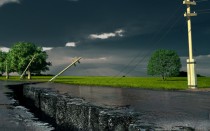Anthony Gucciardi
Activist Post
Significantly more radioactive caesium was released into the atmosphere as a result of the Fukushima explosion than many experts previously stated. A new study challenges the official explanations of the Fukushima explosion, stating that the amount of radioactive isotope caesium-137 released at the height of the crisis was equivalent to 42% of that from Chernobyl. Of course experts have actually declared the Fukushima event to be even more catastrophic than Chernobyl.
The report, published online by the journal Atmospheric Chemistry and Physics, states that Fukushima actually began emitting in the time between being struck by a magnitude-9 earthquake on March 11th and the subsequent arrival of a tsunami around 45 minutes later.
“This early onset of emissions is interesting and may indicate some structural damage to the reactor units during the earthquake,” the report said.
Are officials covering up the truth regarding the spread of caesium-137?
 The government, along with the plant operator Tokyo Electric Power, still continue to assert that the plant managed to withstand the quake but was damaged by waves that breached its protective seawall. However, nuclear experts have accused the plant operators of lying over the events.
The government, along with the plant operator Tokyo Electric Power, still continue to assert that the plant managed to withstand the quake but was damaged by waves that breached its protective seawall. However, nuclear experts have accused the plant operators of lying over the events.
Maxim Shingarkin, an expert in nuclear and radiation security, commented on the situation in Fukushima:
“In fact, this statement came with a big delay. The operating company deliberately concealed this information. The explanation is simple – the company is afraid that any checking by competent experts would reveal its inability to save the situation. Only recently, foreign experts founded a consultative body for the clean-up of the accident’s consequences. Moreover, the company is concealing the information about the amount of pollution of the environment.”
The study also found that caesium-137 emissions dropped quite significantly after emergency workers began dousing a spent fuel pool at the No 4 reactor, going against earlier claims that the pool had not emitted the radioactive isotope. Officials even claim that the radiation levels outside the 12 mile exclusion zone around the Fukushima plant pose no health risks, despite researchers reporting extreme levels of radiation inside of Tokyo.
In fact, researchers have found a large amount of radioactive material exceeding that of the evacuation zone arrive in Tokyo leading to an even greater concern than government officials claimed it would be regarding the Fukushima radiation. What’s more, radioactive isotopes have even been located in California, highlighting the ubiquitous nature of the radioactive material.
So what happened to all of the caesium-137 emitted from the plant?
According to the report, 20% of the caesium-137 fell on Japanese land, and about 2% ended up on land outside the country. The remainder came down in the Pacific Ocean.
Please visit Natural Society for more great health news and vaccine information.



Be the first to comment on "New Study Challenges Official Fukushima Explanation — Radiation Released Exceeds Twice what Experts Claimed"